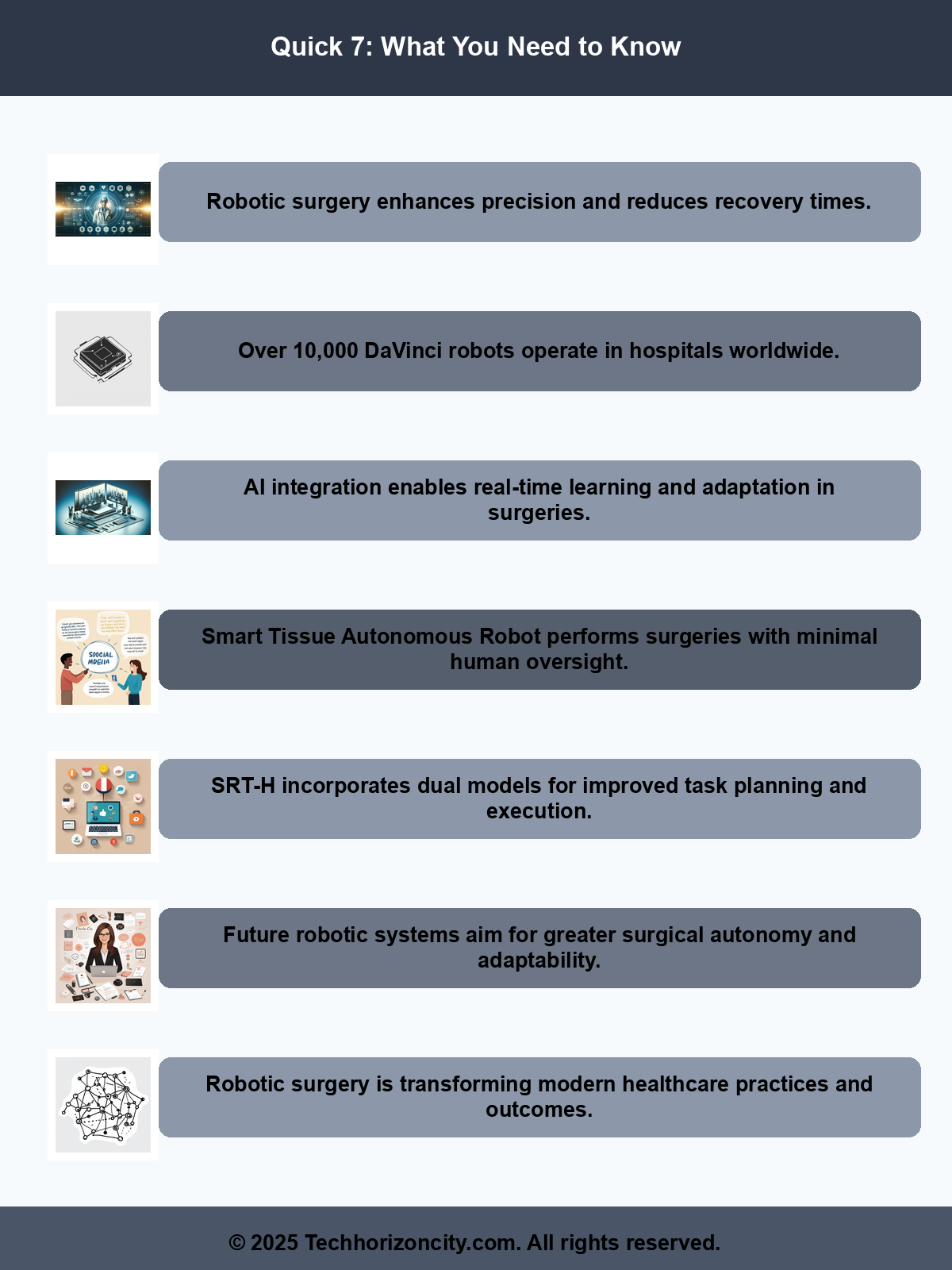Executive Summary
The surgical landscape has experienced a profound transformation since the introduction of robotic systems, particularly with the emergence of the DaVinci surgical robots by Intuitive Surgical in the late 1990s. These advanced machines have paved the way for more precise and minimally invasive surgeries, primarily through teleoperation. However, as we advance further into the era of artificial intelligence, innovative systems like the Surgical Robot Transformer (SRT-H) are poised to redefine the boundaries of surgical autonomy. This blog explores the trajectory of robotic surgery, the integration of AI, and the implications for the future of surgical practices.

Background Context
Robotic surgery has become a significant component of modern healthcare. Intuitive Surgical’s DaVinci system, with over 10,000 units operating in hospitals globally, revolutionized minimally invasive procedures, allowing surgeons to perform complex surgeries with enhanced precision and reduced recovery times. Initially, robotic systems relied on a set of pre-programmed instructions, limiting their adaptability during procedures. This inflexibility often required surgeons to be physically present, operating the robotic arms via a console.
For technical resources and innovative solutions, please visit EchoesOfCreationUS for specialized technical resources.
In 2022, a team from Johns Hopkins University took a significant leap forward by integrating artificial intelligence into a DaVinci robot for gallbladder removal, or cholecystectomy. This advancement reflects a growing trend toward enhancing robotic systems with AI capabilities, aiming to create machines that can learn and adapt in real-time during surgical procedures.
Analysis of Implications
The implementation of AI into robotic surgery opens new avenues for medical practice. With the Smart Tissue Autonomous Robot (STAR) making headlines for executing procedures with marked tissues and predetermined plans, the focus has shifted toward creating systems that can operate with greater autonomy. STAR, developed by Axel Krieger’s team, demonstrated the potential for robotic systems to perform intricate surgeries without direct human oversight. However, its reliance on distinct markings and strict operational protocols presents limitations in flexibility and adaptability.
Discover exclusive offers and premium content at Active Living Offers – your gateway to enhanced productivity and lifestyle solutions.
Enter the SRT-H, developed by Ji Woong Kim and colleagues. This innovative system builds upon the capabilities of the DaVinci robot to incorporate two transformer models for both task planning and execution. This dual approach could enhance the robot’s ability to process information and adjust to unforeseen circumstances during surgery, moving closer to a more autonomous surgical future.
Industry Impact Assessment
The implications of these advancements are profound for the healthcare industry. For one, improved surgical outcomes are anticipated, as robots equipped with AI can analyze data in real-time to make informed decisions, potentially reducing human error. The cholecystectomy procedure alone is performed approximately 700,000 times a year in the U.S., highlighting the demand for enhanced efficiency and outcomes in frequently executed surgeries.
Moreover, the integration of AI into robotic surgery could reshape the training landscape for surgeons. As robots take on more responsibilities, the necessity for exhaustive human oversight may diminish, leading to a redefined surgical education model. Surgeons could focus on higher-level decision-making and complex case management while robotic systems manage more routine tasks.
However, this shift also raises ethical and professional concerns. The potential for job displacement among surgical staff and the need for rigorous oversight of AI-driven systems cannot be overlooked. There will be essential discussions regarding the balance between technology and human skill in surgical environments.
Future Outlook
As we gaze into the future of robotic surgery, the pathway appears both promising and challenging. The trajectory suggests a gradual transition to more autonomous surgical procedures, where AI becomes an integral part of surgical teams. Innovations like the SRT-H will likely spark competition among manufacturers, further enhancing the capabilities of surgical robots.
In addition, the field may witness an increase in collaboration among tech companies, healthcare providers, and researchers to develop more sophisticated systems that can navigate the complexities of human anatomy and respond dynamically to patient needs. The potential for teleoperated surgeries to extend access to quality healthcare in remote areas could also expand, providing patients with care that was previously unavailable.
Conclusion with Key Takeaways
The evolution of robotic surgery, particularly with the integration of AI, marks a significant milestone in modern medicine. While systems like the DaVinci robot have laid the groundwork for minimally invasive procedures, the advent of smarter, more adaptable robots like the SRT-H signifies a shift toward greater autonomy in surgical practice.
Key takeaways include:
- Robotic surgery is evolving from manual control to increased autonomy, driven by AI advancements.
- The integration of AI can enhance surgical precision, potentially improving outcomes and reducing recovery times.
- Ethical considerations surrounding the use of AI in surgery must be addressed as technology progresses.
- The future of surgical training may shift in response to the growing role of AI in surgical procedures.
As we navigate this transformative phase in healthcare, it is essential for medical professionals, technologists, and policymakers to collaborate in ensuring that advancements in robotic surgery enhance patient care and uphold the highest standards of safety and effectiveness.
Disclaimer: This article was independently created based on publicly available information and industry analysis.
